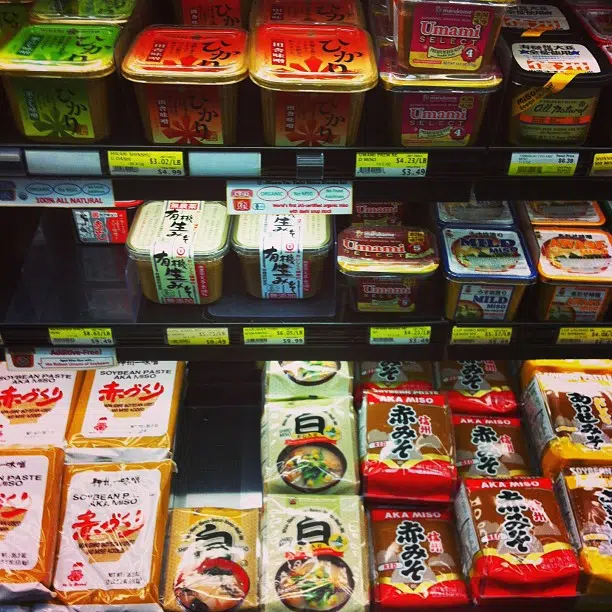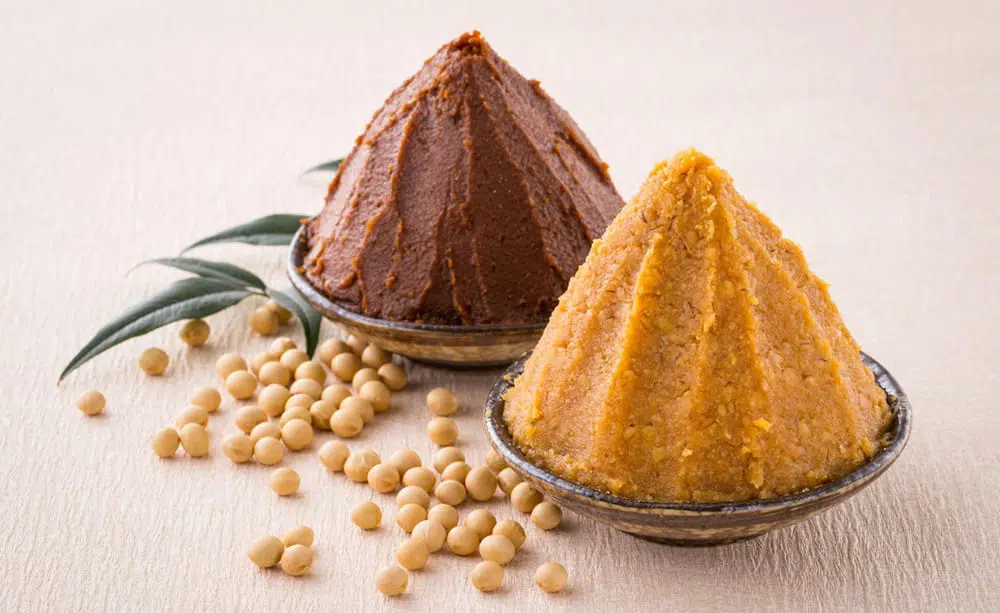When Does Miso Paste Expire? How Long Soybean Paste Lasts
Important Note: When you buy through our links, we may earn a commission. As an Amazon Associate we earn from qualifying purchases. Content, pricing, offers and availability are subject to change at any time - more info.
Delectably umami miso paste, also known as soybean paste, is a Japanese staple that can easily last so long that many find themselves wondering if their batch is still safe to eat. As a highly fermented bean paste and an intense integral component of soy sauce, a little goes a long way. Unless you whip up Asian cuisine like miso soup, glazed Nasu Dengaku, or miso-marinated fish or veggies often, there’s most likely a half-full tub or jar of tangy miso paste waiting in your refrigerator. Does miso paste expire at all? For how long is it still safe to use? Let’s take a closer look.
What Is Miso Paste?
Miso paste is a traditional Japanese seasoning paste made from soybeans combined and fermented with cultured Aspergillus oryzae, otherwise known as kōji mold, for up to two years or more. The filamentous fungus kōji cultivated on rice and other grains aids fermentation while adding umami flavor and sweetness to the paste.
How Is Miso Paste Made?
Making traditional miso paste involves soaking carefully selected soybeans in water, followed by a short steaming process and overnight slow cooking. The soybean mash is then covered with kōji mold growing on either cultured steamed kōji rice or barley amongst various other grains depending on the regional variety. After a period of initial fermentation, water and salt join the miso mix before blending. Finally, the soybean paste is transferred into large wooden vats and left to mature until ready.
What Does Miso Paste Taste Like?

Expect a robust salty-sweet flavor similar to dark soy sauce but richer and more savory, with a thicker texture, subdued earthiness, slight nuttiness, and definite funk. Every variety of miso paste will taste slightly different. The fermentation period, bean quality, and additives all affect the final product in flavor complexity, color, consistency, and aroma. There’s even a distinct difference between store-bought varieties as no single batch produced is the same.
Understanding The Shelf Life Of Soybean Paste
An unopened jar of miso remains safe to use for years due to the fermented, salty nature of the paste. There are many different varieties, but all undergo fermentation for a period ranging between weeks for light miso to a year and a half or more for the darkest pastes. The longer properly stored soybean paste stands, the darker and more savory it becomes, losing sweetness gradually due to the Maillard reaction taking place.
The Maillard reaction turns the fermented miso paste brown as amino acids reduce natural sugars while instilling the unmistakable flavor best recognized as the roasted, toasty goodness of a proper sear or well-browned roast. This reaction during the fermentation and maturation of the paste grants the basic range of colors – intense red miso, mild creamy-yellow miso, and slightly sweet white miso.
Determining when miso paste is no longer safe to use is hard to gauge based on the expiry date and expected shelf life alone. However, the flavor-enhancing properties of long-ripened miso show that the protein, glutamate, and sugar in miso paste continue to evolve for almost two years. Not only does the Maillard reaction happen for 5 to 11 months on average, but the peptide responsible for umami flavor in soybean paste carries on strengthening for up to 20 months later.
Safe Miso Paste Storage Techniques

The correct seal for storing miso calls for an airlock that allows carbon dioxide to escape as starches and sugars break down without allowing any new air into the vessel, thus contaminating the paste. Unless you’ve got a specialized fermentation jar or container ready, there are fortunately several reliable ways to store miso. After all, not every tasty batch of soybean paste comes in the right packaging to mature safely for an extended period after opening.
For most people, the safest way to store miso paste is to cover it in the jar it came in and keep it in the fridge. Cover the container’s mouth with a piece of clean parchment paper cut to size or plastic wrap placed directly against the miso before closing the lid. This will prevent the build-up of any harmful bacteria, stopping air from penetrating the seal.
If you made a large batch at home or bought your soybean paste in bulk, in a plastic tub, or have a small quantity leftover from a single serving, transfer it to a clean, dry sealable container. A glass mason jar or a container made from pottery, enamel, glass, or food-grade plastic just big enough to hold the miso is optimal. Line the bottom of the vessel lightly with kosher/coarse salt and dispense the miso paste. Just as before, cover the paste with parchment or plastic wrap, leaving no air in between, and seal your container for refrigeration.
The best place to store miso paste is in the refrigerator, but storing it in the freezer doesn’t freeze the paste solid and drastically slows the maturation process. Although not completely necessary, freezing soybean paste makes it last even longer while remaining usable directly from the freezer. Some chefs prefer the peace of mind and convenience of knowing that their seasoning paste is never susceptible to dangerous temperature fluctuations and other external contamination.
How Long Does Miso Paste Last?
Without contamination, refrigerated soybean paste can last for years, but both the flavor and color change over time. When unrefrigerated, don’t expect anything more than a few weeks to two months at the most. Always store miso in a cool, humidity-controlled area. Some brands offer pasteurized miso paste without live bacteria that is safe for prolonged pantry storage, so please pay attention to any manufacturer recommendations listed.
The taste of miso paste remains relatively consistent for up to a year after opening if properly refrigerated. After this point, miso’s rich umami flavor, saltiness, and funk mature and intensify while it slowly loses sweetness and its nutty undertones. The darker the miso, the bolder the intensity and saltier the flavor, but the longer the paste matures, the more it loses moisture and thickens.
Eventually, miso paste will mature to the point where it dries out. With the wrong moisture and heat conditions, miso can spoil, but if it’s stored clean in a cool place with limited exposure to air, the paste will turn into a pungent dried form that’s great as a stock. Some cooks even dry out aged soybean paste more to use it as a savory substitute for salt.
The Final Word: Is It Safe To Eat Expired Miso?
Commercial miso paste brands may have an expiry date, but miso technically lasts indefinitely. Please pay attention to the surface of the paste for signs of unwanted bacteria or mold growth, which is almost always accompanied by an undesirable odor and a change to the texture of the paste. If any of this has happened, your miso paste has unfortunately become contaminated and will make you sick – discard immediately. However, most cooks who pay attention to safe storage find that their miso paste is still flavorful and safe to eat for many, many years to come.
























